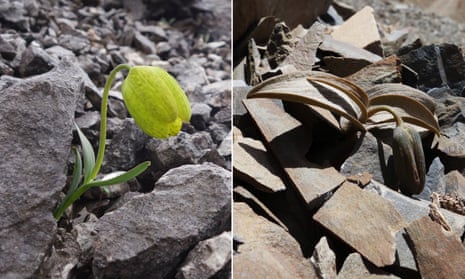For thousands of years, the dainty Fritillaria delavayi has grown slowly on the rocky slopes of the Hengduan mountains in China, producing a bright green flower after its fifth year.
But the conspicuous small plant has one deadly enemy: people, who harvest the flower for traditional Chinese medicine.
As commercial harvesting has intensified, Fritillaria delavayi has vanished – by rapidly evolving to produce grey and brown leaves and flowers that cannot be so easily seen by pickers.
Scientists have discovered that the colour of the plant’s leaves has become more camouflaged – matching the background rocks on which they grow – in areas where there is more harvesting pressure from people.
“Like other camouflaged plants we have studied, we thought the evolution of camouflage of this fritillary had been driven by herbivores, but we didn’t find such animals,” said Dr Yang Niu, of the Kunming Institute of Botany, and co-author of the study in Current Biology. “Then we realised humans could be the reason.”
In the study by the Kunming Institute of Botany (Chinese Academy of Sciences) and the University of Exeter, researchers measured how closely plants from different populations matched their mountain environment and how easy they were to collect, and interviewed local people to estimate how much harvesting took place in each location.
In a computer experiment, people were found to take more time to discover the more-camouflaged plants, suggesting that humans are driving the rapid evolution of this species into new colour forms because better-camouflaged plants have a higher chance of survival.
Fritillaria delavayi is a perennial herb that grows leaves at a young age before producing a single flower after its fifth year every June. The bulb of the fritillary species has been used in traditional Chinese medicine for more than 2,000 years but high prices in recent years have led to increased harvesting.
“It’s remarkable to see how humans can have such a direct and dramatic impact on the colouration of wild organisms, not just on their survival but on their evolution itself,” said Prof Martin Stevens, of the Centre for Ecology and Conservation at the University of Exeter. “Many plants seem to use camouflage to hide from herbivores that may eat them – but here we see camouflage evolving in response to human collectors.
“It’s possible that humans have driven evolution of defensive strategies in other plant species, but surprisingly little research has examined this.”
